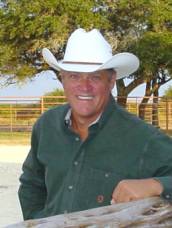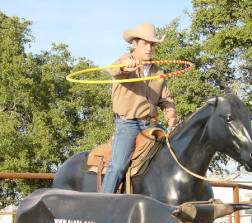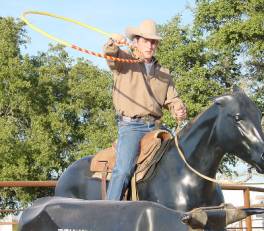|
 THE
ULTIMATE ROPE TRICK !!!
by David E. Jones THE
ULTIMATE ROPE TRICK !!!
by David E. Jones
The “grip” and the
“stance” are arguably the most basic elements of any sport.
How you hold the ball, racket, bat, club or rope determines the
control of the object of the sport.
How you stand determines the balance, stability and the accuracy
in projecting the object of the sport.
When riding and team roping those basic elements become
complicated. The
“stance” is affected by balance and position on the horse and, just
as complicated, the balance and position of the horse are affected by
the “stance”.
If the heading horse doesn’t
“rate” when it approaches the steer or moves forward and left when
the rope is thrown, it may not have anything to do with the horse but
may be the result of how the roper swings and throws the rope.
If the heeling horse “sets up” before the roper is ready to
throw or stops too early in the delivery the problem may not be the
horse either. The roper may
be cueing the horse with the direction and momentum of the swing.
If the heeler swings the loop too far to the left and has to move
across the horse to deliver the loop, the move across the horse and not
the delivery cue the horse to stop.
Changes in the rider’s balance generated by swinging the rope
and the direction the rope is swung affect the roper’s “stance.
And, the roper’s stance determines how the horse will respond.
 The
heading loop swung with the back strand too low and too far behind the
steer’s horns (see simulated loop in photo 1) generates a momentum
that moves from back-right to front-left.
This is where the guy on the fence yells, “Get your elbow
up!” The motion and
momentum are generated in the same direction as the plane of the swing
and the path of the circle. In
photo 1 follow the path of the circle and imagine the direction the
circle would take if no other force were applied to it.
That circle would rise while moving left and forward.
The back strand closer to the steer is not better.
When the back strand is low, the roper will deliver the loop by
twisting the loop to the left and front.
The loop rotates and the back of the loop rises just when the
roper needs the back strand to lower to catch.
The roper is forced to throw the loop back to the right and then
follow through, to the left and front, pushing the front of the loop
over the left horn. If the
loop doesn’t miss completely, it “pops off” after the tip hits the
shoulder of the steer. If
you read this paragraph again there are already four references to
swinging the momentum of the rope and throwing the rope from back-right
to front-left. The
back-right to front-left motion is telegraphed to the horse through the
rider’s stance. When the header is riding to the steer and the momentum of
the swing is forward and left, the horse runs by.
When the header throws the loop forward and left, the horse moves
forward and left or “ducks left”. The
heading loop swung with the back strand too low and too far behind the
steer’s horns (see simulated loop in photo 1) generates a momentum
that moves from back-right to front-left.
This is where the guy on the fence yells, “Get your elbow
up!” The motion and
momentum are generated in the same direction as the plane of the swing
and the path of the circle. In
photo 1 follow the path of the circle and imagine the direction the
circle would take if no other force were applied to it.
That circle would rise while moving left and forward.
The back strand closer to the steer is not better.
When the back strand is low, the roper will deliver the loop by
twisting the loop to the left and front.
The loop rotates and the back of the loop rises just when the
roper needs the back strand to lower to catch.
The roper is forced to throw the loop back to the right and then
follow through, to the left and front, pushing the front of the loop
over the left horn. If the
loop doesn’t miss completely, it “pops off” after the tip hits the
shoulder of the steer. If
you read this paragraph again there are already four references to
swinging the momentum of the rope and throwing the rope from back-right
to front-left. The
back-right to front-left motion is telegraphed to the horse through the
rider’s stance. When the header is riding to the steer and the momentum of
the swing is forward and left, the horse runs by.
When the header throws the loop forward and left, the horse moves
forward and left or “ducks left”.
To catch, without a
“pop-off” and without the horse moving up and out, the back strand
of the loop MUST be going down hill.
Imagine the ultimate rope trick a beginning roper must learn to
be able to move the momentum of the plane of the loop from one place to
another while trying to make the back strand of the loop go down when it
is trying to go up and all the while trying to keep the horse from
“running-by” or “ducking-out”.
What fun is that?
 The
solution can be found in “Science
Based Team Roping Basics”. If
the head loop is swung with the back strand of the loop higher than the
front strand (see simulated loop in photo 2) and the loop is swung in a
plane that allows the roper to come out of the swing by allowing gravity
to move the loop down and momentum to move the loop left, then the back
strand of the loop will be trying to go down hill as the roper is
delivering the loop. In
photo 2 follow the path of that circle and imagine the direction the
circle would take if no other force was applied to it. You will notice that the direction of the circle of the swing
and the The
solution can be found in “Science
Based Team Roping Basics”. If
the head loop is swung with the back strand of the loop higher than the
front strand (see simulated loop in photo 2) and the loop is swung in a
plane that allows the roper to come out of the swing by allowing gravity
to move the loop down and momentum to move the loop left, then the back
strand of the loop will be trying to go down hill as the roper is
delivering the loop. In
photo 2 follow the path of that circle and imagine the direction the
circle would take if no other force was applied to it. You will notice that the direction of the circle of the swing
and the  plane
of the loop are in position to bring the follow-through of the circle up
and back toward the horse. The
plane of the loop and the direction and momentum of the swing allow the
loop to be lowered to the horns with the back strand going down hill
(see photo 3). With the
momentum of the swing coming back toward the horse the horse rates and
doesn’t duck. The back strand of the loop is going down hill and the loop
doesn’t pop off. The
delivery of the loop feels effortless.
Now your horse is easy to ride and you catch.
What fun is that? plane
of the loop are in position to bring the follow-through of the circle up
and back toward the horse. The
plane of the loop and the direction and momentum of the swing allow the
loop to be lowered to the horns with the back strand going down hill
(see photo 3). With the
momentum of the swing coming back toward the horse the horse rates and
doesn’t duck. The back strand of the loop is going down hill and the loop
doesn’t pop off. The
delivery of the loop feels effortless.
Now your horse is easy to ride and you catch.
What fun is that?
Think about this:
- The
back strand of the loop must be moving down hill to catch.
- See
the loop above and to the right of the steer’s horns with the back
strand up (keep the elbow up and the thumb down).
- Imagine
the path the back strand must take to catch and allow enough room
for it to move left and down without a throw changing the direction
of the loop. (If you
want to “reach”, do this part from farther away from the steer)
- Guide
the back strand of the loop on slowly from the top of your swing,
following the circle of the swing.
- If
you feel the throw, the loop isn’t directed accurately.
Everything about roping is a
rope trick. You’ll have
to decide whether you want to learn a hard rope trick or an easy one.
Maybe the ultimate rope trick is the easy one.
Give your horse the direction to
learn what you have learned. It
will take some time. Horses
learn by patterning and repetition.
Maybe will talk about that next time.
Until then – enjoy the
process,
David
|